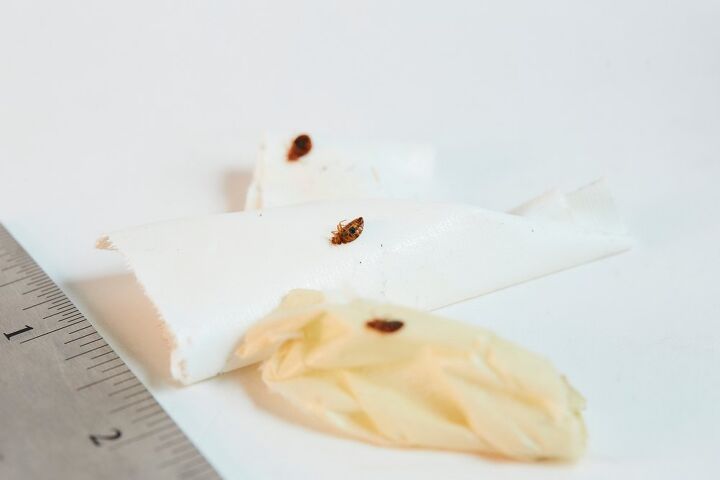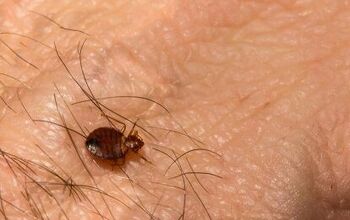Bed Bugs Vs. Roaches: How to Tell the Difference

There are few things more frustrating in the world than bed bugs and roach infestations. If not addressed properly, a cockroach problem can lead to serious health concerns, hygiene issues, and even the spread of diseases. Whereas, neglecting a bed bug infestation can result in major allergies, skin infections, costly remediation, and even a negative impact on your mental health.
Though, since people commonly confuse bed bugs for cockroaches, it’s important that you understand the difference between them. In fact, these two pests do look somewhat similar at certain points in their lifecycles. The easiest way to differentiate between bed bugs and roaches is by looking at the length of their antennae and the shape of their eyes.
If the length of the antennae is as long as the bug’s body, it’s likely a small cockroach. Whereas, if you find a bug crawling on your bed with a small antennae and eyes that protrude out of their body, it’s probably a bed bug. Though, there is much more to this battle of bed bugs vs. roaches than appearance. Continue reading to learn more about how to identify these two pests correctly so that you can deal with the problem accordingly.
Do You Need Pest Control Services?
Get free, zero-commitment quotes from pro contractors near you.

What is a Bed Bug?
Bed bugs are small, flat, oval, flightless insects that survive on the blood of animals and humans. They are reddish-brown in color and usually around the size of an apple seed. Although they have wing-like structure on their backs, bed bugs do not fly. These pests likely get their name from their pattern of taking refuge in beds and feeding on humans while they sleep.
While humans are the most common target, bed bugs will also feed on a number of warm-blooded animals.
They have been linked to humans for over 3,300 years can often be found anywhere where people like to congregate, such as homes, hotels, offices, schools, stores, and even public transportation. Bed bugs are excellent “hitch hikers,” which allows them to travel great distances. They will attach to your clothes, linens, and your suitcase and go wherever these items are taken.
Since bed bugs are often confused with a variety of other pests, detection is difficult which allows growing populations to go unnoticed.
What is a Cockroach?
Cockroaches, or roaches for short, are common pests that infest both residential properties and commercial buildings where they have access to moisture, food, and warmth. There are numerous different species of cockroaches, though only about 30 out of 4,600 species are associated with human habitats. They have flat, oval-shaped bodies, with a small head and six spiny legs.
Some cockroaches also have wings positioned flat against their back, although not all species use the wings to fly. The two most common species of cockroaches found in homes are German cockroaches and American cockroaches. German cockroaches are generally light brown in color and ½ to 5/8 inch long. They are usually found in kitchens and bathrooms, and feed on a wide array of foods.
American cockroaches, on the other hand, have a reddish-brown color and are the largest species that invade homes. Both male and female American cockroaches have wings that they use to fly when they reach adulthood. They are found in a number of places in the home, but prefer temperatures between 70- and 85-degrees Fahrenheit. The presence of American cockroaches is a major public health concern as they can carry and spread a variety of pathogens.
Differences Between Bed Bugs & Roaches
While both pests share some similarities, particularly at a certain age, there are a number of differences that can help you determine which type of bug you may be dealing with.
Appearance
Adult bed bugs are about as small as an apple seed, with flat, oval bodies and wing-like structures on their backs. They can often be identified by their distinctive reddish-brown hue and the fact that they crawl rapidly and bite frequently to feed on your blood. Nymph bed bugs are similar in size to the adults, but lighter in color. Regardless of age, bed bugs have short, thick antennas.
Cockroaches, on the other hand, have a comparatively larger body and are easier to spot from a distance. Their bodies are flat and oval-shaped, with six legs and two long antennae that protrude from their head. Unlike bed bugs, roaches do have wings and can fly, but not every species flies. They can be found in a light tan to brown color, and some are as dark as black.
The best way to visually differentiate between a bed bug and a roach is through their antennae and eyes. Bed bugs have eyes that stick out from the rest of their body and shorter antenna than roaches. In most cases, roaches are also usually considerably larger and easier to spot than bed bugs.
Bites
Both bed bugs and roaches bite, but bed bugs are more known for their bites and bite more often than roaches. This has to do with the fact that bed bugs are parasitic creatures, feeding on human blood for their daily meals. The bites they leave behind are red, swollen, itchy, and can be painful.
Roaches, however, do not bite as much, as they commonly feed on food scraps instead of blood. Though, cockroaches may bite if they do not have an available food source and their only option is to consider whether or not you may be edible.
Bite Effects
The main difference between bed bugs and roach bites is the effect that they cause. As bed bugs are biting you, they use a salivary chemical compound to numb the site so you don’t feel it. That way, they can feed on you without being noticed. However, eventually, your body’s histamine process kicks in and the bites will turn red, swollen, and itchy.
Whereas, since cockroaches don’t typically bite humans and they do not feed on human blood, you will feel their bites immediately. Like bed bugs, their bites will swell and itch. Both types of bites can get infected, but it’s more likely to happen with roach bites due to their unhygienic nature.
Location
Another chief difference between bed bugs and roaches is where you will find them in your home. Both insects choose to congregate close to their food supply. For bed bugs, this means that prefer to live in small, tight bedrooms spaces like in your mattress, in seams of chairs, between cushions, and in bedside furniture.
Roaches, on the other hand, will gather in damp, dark places where food and/or water is available. With this in mind, you’ll often find cockroaches behind your fridge, in your trash cans, behind and under bathroom tiles, inside cabinets and drawers, and virtually any other dark crack or crevice they can hide while they’re searching for food.
Day or Night?
Both bed bugs and roaches are nocturnal pests, meaning it’s unlikely that you’ll see them roaming about during the day. Bed bugs will feed on humans as they sleep at night and during the day they are digesting the blood, laying eggs, or lingering in their hiding spots. If you disturb them during the day, they will just run back to their hiding spot.
Roaches are also nocturnal and will come out at night in search of food sources while everyone is turned in for the night. When compared to bed bugs, though, roaches are more likely to show up during the day. They are agile, fast creatures and thus more confident to come out during the day without getting killed. Though, you’ll only find roaches out during daylight hours if it absolutely necessary for them.
Diseases
Although bed bugs feed on human blood, there is no evidence that links them to the spread of diseases. The itching that appears after a bed bug bite, however, can cause scratching and then lead to an increased risk of skin infection. Since bed bugs usually survive on a single human or a couple that sleeps in the same bed, they usually don’t spread disease.
Cockroaches, though, have much more potential to carry diseases based on their lifestyle and feeding patterns. They live in damp, dark, places close to food supplies, which could be a sewer or trash can. Considering the places they like to linger in, roaches can spread a range of diseases, including typhoid fever, dysentery, diarrhea, and even cholera.
Bed Bugs vs. Baby Roaches
Adult cockroaches will generally not look anything like bed bugs, but often the confusion is between baby roaches and bed bugs. Considering their color and size, bed bugs and baby roaches can look nearly identical. For this reason, it’s common for homeowners to see a baby roach and assume it is just a random bug instead of a potential cockroach infestation.
Because of their size it’s hard to distinguish the difference between a cockroach nymph and a bed bug. The easiest way to differentiate between the two is by looking at their eyes and antennae. If the length of the bug’s antennae is as long as its body, it’s likely a small cockroach. Whereas, if the bug has small antennae and eyes that stick out of its body, you are probably dealing with a bed bug infestation.
Do You Need Pest Control Services?
Get free, zero-commitment quotes from pro contractors near you.

Which is Worse: Bed Bugs or Roaches?
Although both bed bug and roach infestations are a pain, you must consider a number of factors in order to determine which is worse to have. When you factor in how they bit, their size, how often they bite, their impact on humans, places where they infest, and how hard it is to eliminate them, many find that bed bugs are worse than roaches.
This simply has to do with the fact that bed bugs are a much more challenging and complicated process to get rid of than roaches. While roaches can spread diseases, they are bigger and easier to spot. This makes locating them and eliminating the problem much easier.
Related Guide

Jessica considers herself a home improvement and design enthusiast. She grew up surrounded by constant home improvement projects and owes most of what she knows to helping her dad renovate her childhood home. Being a Los Angeles resident, Jessica spends a lot of her time looking for her next DIY project and sharing her love for home design.
More by Jessica Stone















![10 Best Cordless Leaf Blowers – [2022 Reviews & Ultimate Guide]](https://cdn-fastly.upgradedhome.com/media/2023/07/31/9070789/10-best-cordless-leaf-blowers-2022-reviews-ultimate-guide.jpg?size=350x220)













